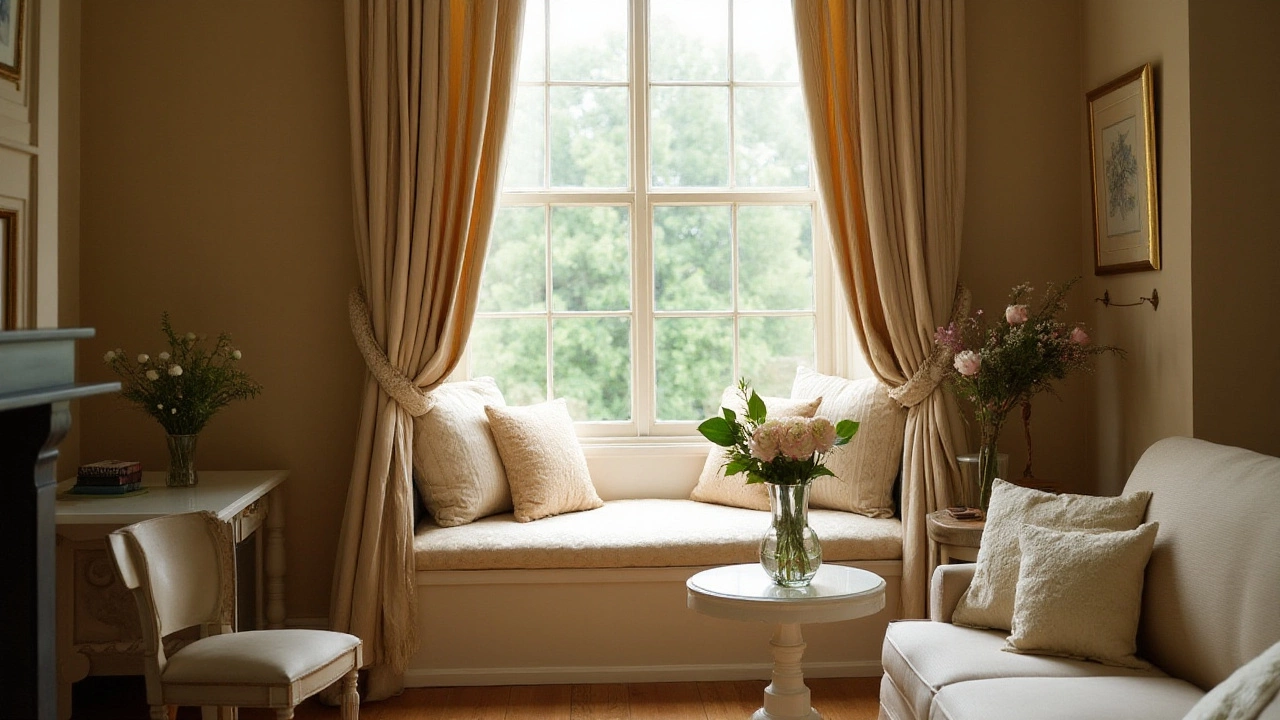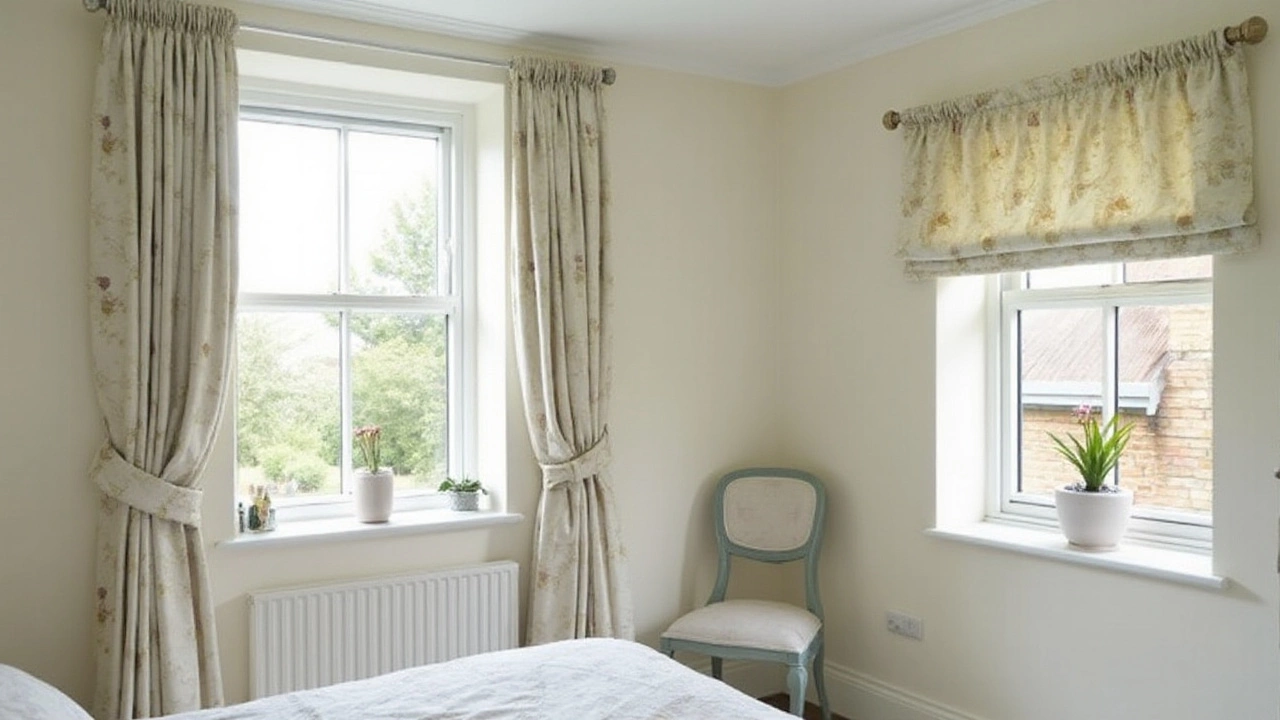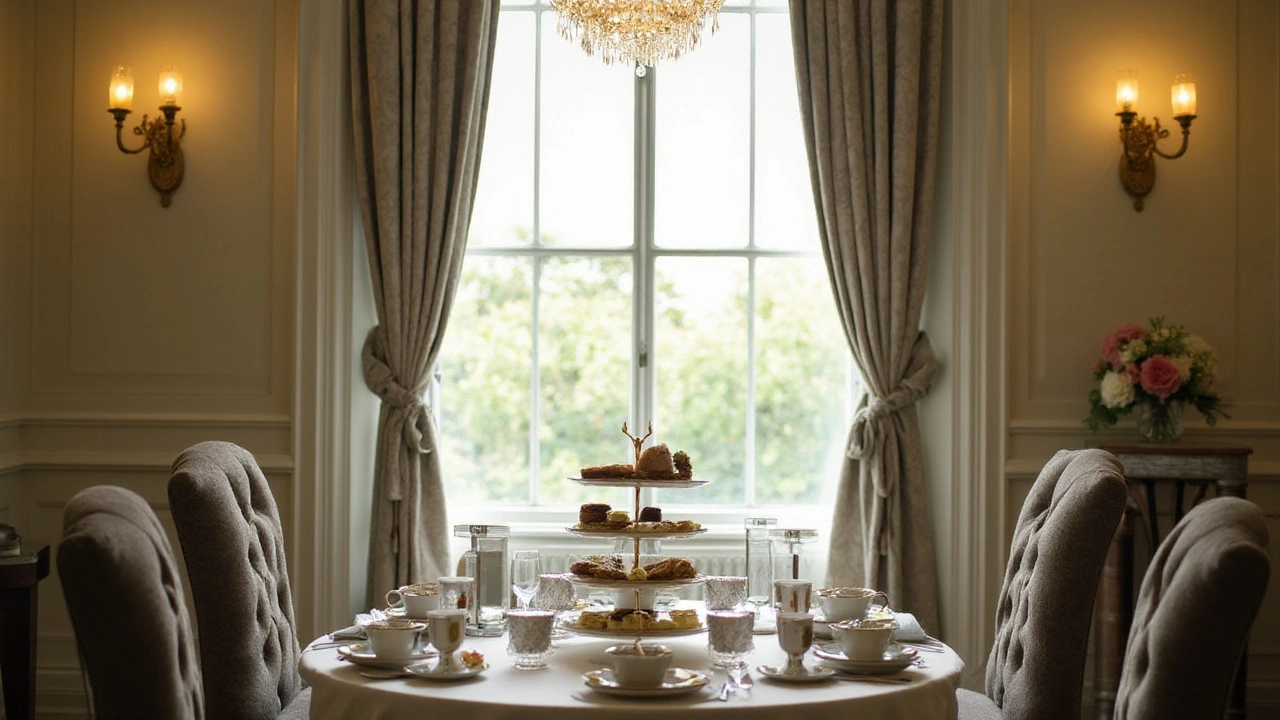Optimal Curtain Lengths: Finding Your Perfect Fit
 Jan, 30 2025
Jan, 30 2025
Choosing the perfect curtain length is like selecting the finishing touch to a beautiful painting. Your choice can either complement the whole room or stand awkwardly like an ill-fitted coat. Curtains, after all, are more than just a shield against peeping eyes or sunlight; they are a critical part of your home's personality. They bring softness, texture, and color, transforming simple walls into statements.
Diving into the world of curtain lengths may seem trivial, but exploring how different sizes impact room aesthetics can make all the difference. From the classic floor-to-ceiling drape that whispers sophistication, to a breezier sill-length that shouts casual comfort, each choice tailors your space's vibe. Understanding the variety of lengths and their practical implications will not just update your decor; it will renew your space's spirit.
- Understanding Curtain Length Options
- Factors Influencing Curtain Length Choice
- Common Mistakes When Choosing Curtain Lengths
- Tips for Selecting the Ideal Length
- Maintaining and Adapting Curtain Lengths Over Time
Understanding Curtain Length Options
When it comes to dressing windows, the length of your curtain can set the tone for the entire room. This stylistic choice impacts the perception of height, width, and even the atmosphere of the space. Traditionally, curtain lengths range from the delightfully dramatic floor-length to the refreshingly simple sill-length, with each option offering unique attributes. Floor-length curtains are generally considered the epitome of elegance, perfect for homes aiming to project sophistication. They provide luxurious streams of fabric flowing quite literally from the ceiling to the floor, enhancing the perceived height of a room.
Interestingly, this style is not without practical considerations. The length ensures minimal light escape, providing an unobstructed blackout effect, which can contribute significantly to energy savings by reducing cooling or heating needs. According to a study from Journal of Interior and Product Design, certain window treatments can indeed influence thermal comfort, showcasing that stylish pieces can be highly functional too. A downside, however, of the sweeping, floor-length charm is the possibility of dirt collection, an issue more profound in households with pets or young children.
In contrast, sill-length curtains offer a more relaxed, breezy vibe. These curtains typically stop just at the window sill, reflecting casual comfort and are often used in kitchens or bathrooms where full-length curtains are impractical. Then you have café-style curtains, splitting the window roughly in half, mainly for those seeking a balance between natural light and privacy. These shorter varieties are common in rustic or vintage-themed decor, offering quaint charm with minimal fabric.
Some homeowners prefer puddle-length curtains, which extend beyond the floor, allowing fabric to pool gracefully. This is often used in formal settings where drama and opulence are appreciated, though it demands regular maintenance to avoid dust accumulation. Another option worth exploring is the tier-style, which uses multiple panels at different heights, providing unique versatility and visual interest. Understanding these various curtain styles can greatly aid in choosing the best fit for your room's needs and aesthetics.
"Curtains are not just for aesthetics. They play crucial roles in energy efficiency and acoustics," says interior designer Sarah Richardson, emphasizing their multifaceted benefits.
In deciding the perfect length, consider not just your room's theme but practical aspects like foot traffic, presence of pets, or even how often you open windows. Making the right choice involves weighing aesthetic ideals with functional needs, ensuring your home decor aligns beautifully with your lifestyle.
Factors Influencing Curtain Length Choice
Deciding on the right curtain lengths can often feel more complex than expected, thanks to a variety of influential factors. One of the primary considerations is room height. For high ceilings, opting for curtains that hang close to the ceiling and extend to the floor helps create a grand illusion, emphasizing the room's vertical space and making it look even taller. In contrast, lower ceilings may benefit from curtains that just brush the floor, adding to the visual length of the walls without overwhelming the room.
Next, consider the practical elements like window size and shape. Larger windows demand more fabric or longer drops to ensure they retain a sense of proportion and balance. High-headed windows can benefit from full-length drapery, adding drama and functionality, while smaller windows can achieve elegance with sill-length curtains that don't clutter the space.
Another often overlooked but crucial factor is the style of the room and the desired aesthetic. Modern spaces may lean towards a cleaner look with floor-grazing or slightly puddled curtains, illustrating simplicity and understated elegance. On the other hand, more traditional or eclectic themes allow for puddled curtains, which involve an extra length of fabric pooling on the floor, evoking a sense of luxury and abundance. Noted interior designer, Jamie Drake, once said,
“Curtains are not just about function; they are an expression of style and taste, reflecting the homeowner's personality.”This encapsulates the essence of aesthetic purpose in curtain choice.
Fabric choice also plays a vital role in determining the ideal curtain length. Heavier fabrics like velvet or brocade provide more structure and are typically better suited for formal rooms where a longer, more tailored look is desired. Conversely, lighter materials such as linen or cotton can afford to be shorter, offering a relaxed feel perfect for informal areas including kitchens and casual living spaces.
As a practical note, it’s important also to consider the curtain rod’s placement. The position of the rod greatly influences how the curtains hang and how they appear in context with the room’s scale. A well-placed rod can enhance the perception of height and width, contributing significantly to achieving a balanced look that complements the property's dimensions.
Finally, think about the purpose of the curtain styles you choose. Are they purely decorative, or do they need to block out light entirely? For example, in a bedroom setting, floor-length blackout curtains might provide the most benefits, offering both privacy and a darkened environment conducive to rest. Meanwhile, a semi-sheer curtain might suffice in a living room where you prefer more natural light. Understanding the practical needs alongside the aesthetic desires ensures that the curtain length serves both functional and decorative goals effectively.
In essence, choosing the correct curtain length involves balancing a myriad of factors, each contributing to the overall feel and function of a space. By taking into account these elements, homeowners can select the perfect drapery to enhance their home’s aesthetic while meeting practical needs.

Common Mistakes When Choosing Curtain Lengths
Embarking on the quest to find the perfect curtain lengths can often lead one down a rabbit hole of options and styles. Sadly, plenty of pitfalls await those unprepared. The most frequent blunder has to be neglecting the functional aspect of curtains. Yes, they should look fabulous, but they must also perform, whether that's shading from the sun or retaining warmth. Many people get swept up solely in the aesthetics and forget to check if the curtains can actually be drawn across their windows easily, or if they billow awkwardly when a window is open. Another misstep folks make is not measuring correctly. Everyone assumes their eye can gauge distance, but a miscalculation of even an inch can leave your curtains looking awkwardly short or dustily long.
Let's face it; curtains can be an investment. You're not just buying fabric; you're adding character to your home. Trying to skimp can be a mistake. Opting for cheaper materials not only impacts durability but also affects how they hang and flow. Natural fibers have a way of draping beautifully, while cheaper synthetic options might seem cost-effective but they don't offer the same elegance or longevity. This is not to say high cost always equals high quality, but be cautious and do your homework on material benefits and limitations. It's a balancing act between budget and style.
Home decor trends can be rather persuasive, encouraging homeowners to jump on board with the latest fads. What the stylists and influencers might not stress is that not every trendy style suits every space. A modern space with sleek furniture might look great with straight, floor-length curtains, but these could drown a cozy, country-style living room. Remember, trends fade, but your decor should endure, reflecting your personal style instead of fleeting fashions. A case in point, many an adventurous decorator has fallen into the trap of the ultra-sleek, puddle-curtain trend, where fabric deliberately pools on the floor. While gorgeous in a magazine, in reality, they're tripping hazards and dirt magnets.
“Good design doesn’t date,” says Harry Seidler, a renowned architect. This quote rings true in the realm of curtain lengths. Ignoring the scale and dimensions of your room can have disastrous effects on how light interacts within the space. For instance, shorter curtains in an already small room can chop up the vertical lines and make a space feel cramped. Yet, in a larger, more grand setup, they can convey a casual energy perfectly suited for informal gatherings. Consider the height of your windows—the higher the windows, the longer the curtains should be to maintain a cohesive look. On the opposite side, pairing a tall window with curtains that don’t reach the floor can make even the grandest window look oddly out of place.
Another common error is disregarding how curtain styles pair with existing elements. Existing colors, textures, and patterns in the room should harmonize with your curtain choice. Often, mismatched selections can lead to a discordant feeling. It's always a good idea to bring home swatches or samples before committing to a full set of curtains. This gives a clear perspective on how the fabric works with different lighting conditions as well. Taking a bit of time to compare can aid in avoiding the mistake of clashing elements, ensuring your curtains complement the holistic picture.
Tips for Selecting the Ideal Length
When it comes to the delicate art of choosing curtain lengths, a bit of forethought goes a long way. A well-selected length not only enhances home decor but also solves practical needs ingeniously. One of the first steps is to decide the purpose your curtain will serve. Are you looking for privacy, a pop of color, light control, or simply framing a view? The answers to these questions will lend you the insight needed to pick between the lavish pool of fabric gracing the floor and the measured elegance stopping at the sill. Do remember that different rooms might demand different lengths due to their varying functionalities and aesthetics.
Measure twice, cut once, they say, and this couldn't ring truer when it comes to curtain lengths. Investing in a measuring tape and taking precise measurements from the rod to your desired stopping point, be it the windowsill or all the way to the floor, will prevent costly mishaps. Always keep in mind that curtains typically hang above ground slightly to avoid gathering dust and making cleaning easier. For those who are both blessed and challenged by high ceilings, long drapes that break gently at the floor could be an eloquent choice, giving any space an air of drama and luxury.
Room type and architecture play pivotal roles too. In relaxed, informal spaces like kitchens or breakfast nooks, selecting sill-length curtains emanates casual charm. Whereas, in formal settings like dining rooms or living rooms, floor-length or even puddled curtains feel more sophisticated. Don’t shy away from experimenting with layering as well. Combining blinds or sheers with traditional drapes can effectively tackle light control while offering varied stylistic appeals. A survey by the American Society of Interior Designers stated that 45% of homeowners preferred layered window treatments for their versatility.
Color and pattern should resonate with the room’s palette and motifs. A daring print might captivate and make a statement, but be cautious not to overload a room with visual clutter. Neutral tones are the saviors for spaces where calmness and simplicity rule. According to interior designer Nathan Turner,
"Curtains are the lipstick of the living space – they have the power to captivate without overwhelming."Keeping this ethos in mind, match the curtain to at least one color from the room's existing design scheme.
It's important to recognize that trends come and go, but functional aesthetics stand the test of time. Maintaining a balance between what’s in vogue and what feels timeless suits most homeowners. When selecting weights and materials, consider the room's climatic and lighting needs—heavier fabrics like velvet can wonderfully insulate and darken rooms, while lighter materials breathe space and light into areas. In studies conducted by the Home Design Research Institute, 60% of respondents believed that curtains significantly impacted room temperature stability and thus, energy consumption during extreme weather.

Maintaining and Adapting Curtain Lengths Over Time
Every home tells a story, and the curtains are a chapter of their own. The life of your curtains will not be static—inevitably, they will need care and sometimes a new look. Maintaining them ensures they always look their best, playing their part in your decor narrative. Dust and sun exposure can dull fabrics, so regular vacuuming with a gentle brush can be a diligent routine. It's also wise to rotate the curtains within the room or among different windows if fabric fading is a concern due to sunlight.
Seasons change and so do our tastes. It’s not uncommon to feel the need to change curtain lengths, perhaps after a new furniture arrangement or a flooring upgrade. Hemming oversized curtains to a *sill-length* can suddenly refresh a room’s vibe. Conversely, adding length with creative extensions for a *floor-length* can elevate a cozy space’s elegance—simple fabric additions at the bottom can be surprisingly transformative. Be bold; fabrics have a way of telling new stories, even with small changes.
Embracing Versatility and Flexibility
Don’t be afraid to experiment with different curtain lengths throughout the year. For instance, shorter curtains might allow a cooling breeze during the summer months, whereas longer, heavier curtains add warmth in winter. Consider opting for curtains that are easy to modify, like those with hooks or button extensions, ensuring adaptability for any season or style shift.
Curtain styles come and go, yet truly timeless decor involves pieces that can effortlessly adapt to trends without substantial investment. According to renowned interior designer, Jane Lockhart,
"The best window treatment decisions blend functionality with personal style, allowing the room to breathe and evolve."Lockhart's wisdom emphasizes investing in quality pieces while keeping a playful openness to **home decor** changes. Years from now, you might find yourself in a completely different style of curating depth and texture to your rooms simply by playing with curtain lengths.
Proactive Curtain Adaptation Techniques
- Regularly adjust curtain rod heights to suit evolving tastes or ceiling height adjustments.
- Purchase curtains with extra fabric so future alterations don't require new curtains.
- Prioritize neutral colors which adapt well with changing room designs.
- Keep a sewing kit or local service handy for quick alterations when needed.
Whether it's adjustments for fresh paintwork or stemming from repair interests, patience and thoughtful selections will serve you well. Be it washing or rehanging, keep an eye on the curtain’s length, ensuring hems remain intact or invisible. Adaptability is the secret to generating long-lasting style from window **treatments**. Your space may age, but your curtains will teach you to evolve with time. Each thread and fold becomes a lesson in resilience and beauty, an eloquent testament to living harmoniously with change.